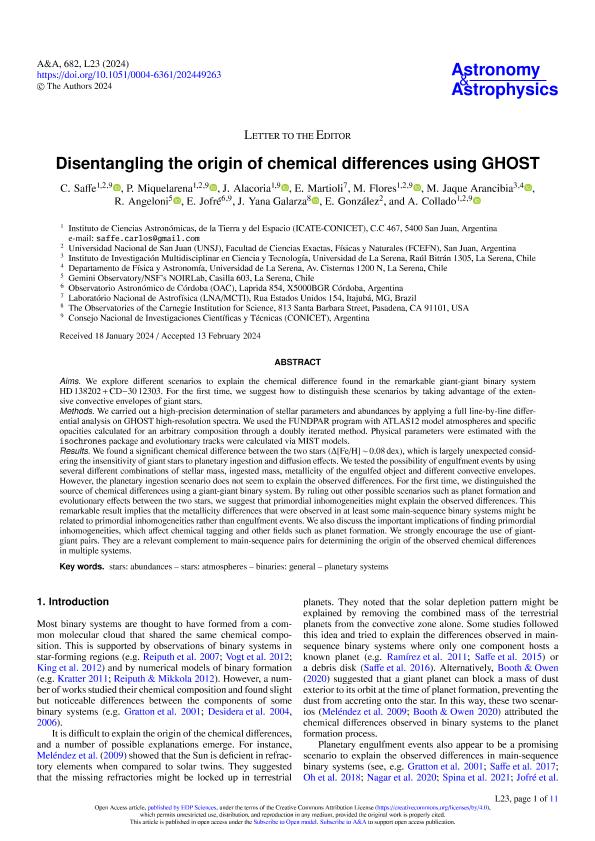Mostrar el registro sencillo del ítem
dc.contributor.author
Saffe, Carlos

dc.contributor.author
Miquelarena Hollger, Paula Andrea

dc.contributor.author
Alacoria, José Alberto

dc.contributor.author
Martioli, E.
dc.contributor.author
Flores, M.
dc.contributor.author
Jaque Arancibia, M.
dc.contributor.author
Angeloni, R.
dc.contributor.author
Jofré, E.
dc.contributor.author
Yana Galarza, J.
dc.contributor.author
González, E.
dc.contributor.author
Collado, Ana Elisa

dc.date.available
2024-03-21T12:39:50Z
dc.date.issued
2024-02
dc.identifier.citation
Saffe, Carlos; Miquelarena Hollger, Paula Andrea; Alacoria, José Alberto; Martioli, E.; Flores, M.; et al.; Disentangling the origin of chemical differences using GHOST; EDP Sciences; Astronomy and Astrophysics; 682; 2-2024; 1-11
dc.identifier.issn
0004-6361
dc.identifier.uri
http://hdl.handle.net/11336/231130
dc.description.abstract
Aims. We explore different scenarios to explain the chemical difference found in the remarkable giant-giant binary system HD 138202 + CD-30 12303. For the first time, we suggest how to distinguish these scenarios by taking advantage of the extensive convective envelopes of giant stars. Methods. We carried out a high-precision determination of stellar parameters and abundances by applying a full line-by-line differential analysis on GHOST high-resolution spectra. We used the FUNDPAR program with ATLAS12 model atmospheres and specific opacities calculated for an arbitrary composition through a doubly iterated method. Physical parameters were estimated with the isochrones package and evolutionary tracks were calculated via MIST models. Results. We found a significant chemical difference between the two stars (∆[Fe/H] ∼ 0.08 dex), which is largely unexpected considering the insensitivity of giant stars to planetary ingestion and diffusion effects. We tested the possibility of engulfment events by using several different combinations of stellar mass, ingested mass, metallicity of the engulfed object and different convective envelopes. However, the planetary ingestion scenario does not seem to explain the observed differences. For the first time, we distinguished the source of chemical differences using a giant-giant binary system. By ruling out other possible scenarios such as planet formation and evolutionary effects between the two stars, we suggest that primordial inhomogeneities might explain the observed differences. This remarkable result implies that the metallicity differences that were observed in at least some main-sequence binary systems might be related to primordial inhomogeneities rather than engulfment events. We also discuss the important implications of finding primordial inhomogeneities, which affect chemical tagging and other fields such as planet formation. We strongly encourage the use of giant-giant pairs. They are a relevant complement to main-sequence pairs for determining the origin of the observed chemical differences in multiple systems.
dc.format
application/pdf
dc.language.iso
eng
dc.publisher
EDP Sciences

dc.rights
info:eu-repo/semantics/openAccess
dc.rights.uri
https://creativecommons.org/licenses/by-nc-sa/2.5/ar/
dc.subject
STARS: ABUNDANCES
dc.subject
STARS: ATMOSPHERES
dc.subject
BINARIES: GENERAL - PLANETARY SYSTEMS
dc.subject.classification
Astronomía

dc.subject.classification
Ciencias Físicas

dc.subject.classification
CIENCIAS NATURALES Y EXACTAS

dc.title
Disentangling the origin of chemical differences using GHOST
dc.type
info:eu-repo/semantics/article
dc.type
info:ar-repo/semantics/artículo
dc.type
info:eu-repo/semantics/publishedVersion
dc.date.updated
2024-03-19T14:07:48Z
dc.journal.volume
682
dc.journal.pagination
1-11
dc.journal.pais
Francia

dc.journal.ciudad
Paris
dc.description.fil
Fil: Saffe, Carlos. Consejo Nacional de Investigaciones Científicas y Técnicas. Centro Científico Tecnológico Conicet - San Juan. Instituto de Ciencias Astronómicas, de la Tierra y del Espacio. Universidad Nacional de San Juan. Instituto de Ciencias Astronómicas, de la Tierra y del Espacio; Argentina
dc.description.fil
Fil: Miquelarena Hollger, Paula Andrea. Consejo Nacional de Investigaciones Científicas y Técnicas. Centro Científico Tecnológico Conicet - San Juan. Instituto de Ciencias Astronómicas, de la Tierra y del Espacio. Universidad Nacional de San Juan. Instituto de Ciencias Astronómicas, de la Tierra y del Espacio; Argentina
dc.description.fil
Fil: Alacoria, José Alberto. Consejo Nacional de Investigaciones Científicas y Técnicas. Centro Científico Tecnológico Conicet - San Juan. Instituto de Ciencias Astronómicas, de la Tierra y del Espacio. Universidad Nacional de San Juan. Instituto de Ciencias Astronómicas, de la Tierra y del Espacio; Argentina
dc.description.fil
Fil: Martioli, E.. Laboratório Nacional de Astrofísica; Brasil
dc.description.fil
Fil: Flores, M.. Consejo Nacional de Investigaciones Científicas y Técnicas. Centro Científico Tecnológico Conicet - San Juan. Instituto de Ciencias Astronómicas, de la Tierra y del Espacio. Universidad Nacional de San Juan. Instituto de Ciencias Astronómicas, de la Tierra y del Espacio; Argentina
dc.description.fil
Fil: Jaque Arancibia, M.. Universidad de La Serena; Chile
dc.description.fil
Fil: Angeloni, R.. Universidad de La Serena; Chile
dc.description.fil
Fil: Jofré, E.. Universidad Nacional de Córdoba. Observatorio Astronómico de Córdoba; Argentina
dc.description.fil
Fil: Yana Galarza, J.. Carnegie Institution For Science;
dc.description.fil
Fil: González, E.. Universidad Nacional de San Juan. Facultad de Ciencias Exactas, Físicas y Naturales. Departamento de Geofísica y Astronomía; Argentina
dc.description.fil
Fil: Collado, Ana Elisa. Consejo Nacional de Investigaciones Científicas y Técnicas. Centro Científico Tecnológico Conicet - San Juan. Instituto de Ciencias Astronómicas, de la Tierra y del Espacio. Universidad Nacional de San Juan. Instituto de Ciencias Astronómicas, de la Tierra y del Espacio; Argentina
dc.journal.title
Astronomy and Astrophysics

dc.relation.alternativeid
info:eu-repo/semantics/altIdentifier/url/https://www.aanda.org/10.1051/0004-6361/202449263
dc.relation.alternativeid
info:eu-repo/semantics/altIdentifier/doi/https://doi.org/10.1051/0004-6361/202449263
Archivos asociados
